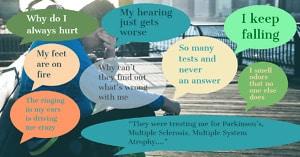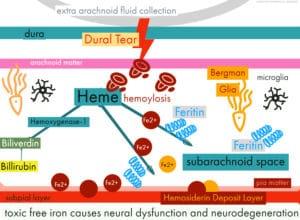Superficial Siderosis. Subpial Siderosis. Infratentorial Superficial Siderosis. No matter how your doctor officially labels your diagnosis odds are no one has the slightest idea of the battle you are about to face. A rare neurodegenerative disorder so uncommon it’s often not recognized by the rare disease organizations tasked with supporting us.

What is Superficial Siderosis?
Superficial Siderosis is a slowly progressive chronic neurodegenerative disorder. It is not a genetic disease, and Superficial Siderosis isn’t contagious. Its cause is often a past trauma, surgery, aneurysm, or some event that resulted in chronic subarachnoid bleeding. The average body is designed to rid itself naturally of blood infiltration into the subarachnoid space, but in rare cases, this slow long-term bleeding overwhelms your system.¹
Explaining the process requires some big and complicated words. Not big as in real size or number of letters in a word but in the sense of consequences. Yes, it progresses slowly for a good portion of sufferers, but what if those early years are spent searching for an explanation of random symptoms? Imagine living through a decade of endless testing and frustration with no answers.
How does Superficial Siderosis develop?
As individual blood cells travel through your subarachnoid space, they begin to rupture through a process called Hemolysis. The bursting of cell walls creates a heme overload that triggers the Bergman glia and microglial cells to fight back by producing the enzyme heme oxygenase-1. This enzyme breaks down the heme and results in the release of free iron molecules, carbon dioxide, and biliverdin. Your body converts biliverdin into bilirubin and routes it out of your system through your liver.

Eventually, the iron molecules attach themselves forming a layer of hemosiderin on the subpial layer that covers the nooks and crannies of your brain and spinal cord. Gravity comes into play. Laying down or sleeping positions the cerebellum to become a prime target. Walking or sitting upright makes your spine at risk the remainder of the day. Cranial nerve sections that run through your spinal fluid also become covered in hemosiderin.
Long-term exposure to free-iron molecules and hemosiderin are toxic resulting in neural damage, cerebellar and neurodegeneration.
What symptoms are Superficial Siderosis related?
It’s frustrating trying to find out if a problem you’re having is related to your Superficial Siderosis or it stems from an unrelated health issue. Many are battling multiple conditions or non-related disease. Care must be taken not to fall into the trap of blaming Superficial Siderosis for everything.
Historically, studies always list the classic triad symptoms: Ataxia, Sensorineural Hearing Loss, and Myelopathy². These three symptom categories are easy to present in a neat bundle, but if you look carefully into the problems most often reported by Superficial Siderosis diagnosees, you find the clinical symptom list is a little more complicated than the classic trio.
Our first posting in 2015 was to list 30 problems thought to be Superficial Siderosis related. Over the past three years, this list has evolved into a searchable glossary. A few of the original symptoms, such as tremors and dental pain are temporarily gone, still awaiting documentation.
Is there new information?
A recent explosion of published studies has yielded 32 documented clinical symptoms found to affect a person with Superficial Siderosis. Most track to one of the three parent categories. A few, such as Depression, Craniospinal Hypotension, and Neurological Reserve³ aren’t direct clinical symptoms but have an obvious connection. No one, to my knowledge, has experienced all of them.
The glossary continues to be a work-in-progress, ever-evolving and expanding as we review new information. Having the opportunity to ask questions in a support group is a big plus, but some issues like male sexual dysfunction and the newly added female sexual dysfunction are incredibly personal. An anonymous searchable resource can ease the anxiety of putting your business out there. Now linked to two medical websites as a reference for Superficial Siderosis, some glossary explanations are still very lean on facts, but the work to develop this section continues, prioritized now by interest.
The Superficial Siderosis Patient Registry
While Living With Superficial Siderosis played a technical role in the creation of your new patient registry it would never have come to exist without the creative input from members of the Superficial Siderosis community. It really does belong to everyone. We’re just temporary caretakers until it can become a self-sustaining resource. If you haven’t had a chance to visit the website please do. We’re not looking to intrude in your lives, any information you chose to divulge is voluntary. We just want to show the world we exist. We need research. We need more physician education and We Are Stronger Together than fighting this alone. https://superficialsiderosispatientregistry.org/

